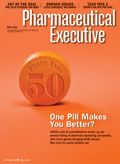Five Policies for Pharma's Big 50
Pharmaceutical Executive
Cash-rich Big Pharmas are hedging their bets to cover both segments under the rubric of "diversification." If it sticks to the wall, then buy it.
This month's lead feature is our annual snapshot of the state of the industry—the Pharm Exec 50. The numbers show a closing of the ranks around a few dominant companies supplemented by an upstart class of "stealth pharma" players whose prospects rest on the potential of two distinct delivery platforms: branded or commoditized generics; and costly, patented, research-intensive biotech drugs. Given the different strategic and tactical approaches required to prevail in these spaces, it's no wonder the industry business model is having a bipolar breakdown. It also explains why cash-rich Big Pharmas are hedging their bets to cover both segments under the rubric of "diversification."

William Looney
Our second window on the future is the annual Roundtable Q&A on the prospects for industry dealmaking in 2010. Eight experts from Big Pharma, biotech, and the investment analyst community convened at the Pharm Exec offices to assess the recovery from the financing recession of the past 18 months. While new survey data from Campbell Alliance shows an upswing in dealmaking activity beginning in the final quarter of 2009, the group concluded that sustained growth depends on improving companies' internal capacity to foster productive collaborations.
In fact, most good deals are going to progress as a natural corollary to longstanding, mutually reinforcing relationships rather than simply being sales to the highest bidder. The ability to connect with partners is key, and depends on marshaling the operational elements of speed, flexibility, accountability, and transparency behind the "partner of choice." That more of these partnerships will be sealed between Big Pharmas—rather than with the traditional cohort of smaller, cash-poor firms—is a measure of how things are changing; it reveals that innovation as a function or process is today more vital than product price as the driver of competitive success.
If discontinuity is the guide to the future, our c-suite readers must know that career progression requires a stretch in mindset. It will demand building the predictive, intuitive, and tone-sensitive skills to better scan the horizon. With the "state of industry" in mind, here is set of drivers for the industry's future—the Pharma Policy Five that will shape the rankings for the next generation of the Pharm Exec 50:
1. Replenishing the drug pipeline a) diversification to spread risk; b) prioritizing new disease targets through personalized medicine; c) internal efficiencies to reduce Phase III failures; d) externalization of the R&D function; e) the possibility of Big Pharma as biotech marketing/distribution platform
2. Maintaining value through the product life cycle a) corrosion of the IP consensus; b) risk-averse regulation and longer waits for license approval; c) crowded therapeutic categories and more competition within class; d) strategies to push faster market uptake; e) repositioning products for new post-patent growth
3. Securing market access a) payer and provider consolidation, industry as a "price taker"; b) commoditization of chronic care drugs and loss of price flexibility in oncology/specialty segment; c) competitive differentiation as key driver of value; d) substantial new investments in evidence/information technologies; e) institutional reforms to drive success in high-growth emerging markets
4. Achieving global operational efficiencies a) rationalization of the manufacturing supply chain across geographies; b) outsourcing high cost R&D functions; c) managing a more diverse, scaled-down knowledge workforce
5. Improving industry's societal reputation a) establishing transparency as an ingrained business practice; b) recasting drug promotion as measure of good science; c) anticipating changing expectations of the patient; d) Expanding networks of stakeholders
William Looney
Editor-in-chief

Addressing Disparities in Psoriasis Trials: Takeda's Strategies for Inclusivity in Clinical Research
April 14th 2025LaShell Robinson, Head of Global Feasibility and Trial Equity at Takeda, speaks about the company's strategies to engage patients in underrepresented populations in its phase III psoriasis trials.
Beyond the Prescription: Pharma's Role in Digital Health Conversations
April 1st 2025Join us for an insightful conversation with Jennifer Harakal, Head of Regulatory Affairs at Canopy Life Sciences, as we unpack the evolving intersection of social media and healthcare decisions. Discover how pharmaceutical companies can navigate regulatory challenges while meaningfully engaging with consumers in digital spaces. Jennifer shares expert strategies for responsible marketing, working with influencers, and creating educational content that bridges the gap between patients and healthcare providers. A must-listen for pharma marketers looking to build trust and compliance in today's social media landscape.